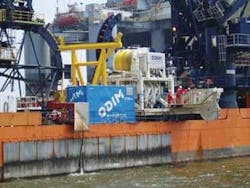Fiber rope system scores heavily over wire for deepwater installations
Subsea 7 is using the ODIM CTCU (Cable Traction Control Unit) system to install subsea structures for theIndependence Hub development in the Gulf of Mexico.
The installation program, employing the monohull pipelay/construction vessels,Toisa Perseus, began last September and is due to continue until June, by which time some 100 lifts will have been completed at five locations in water depths ranging from 2,500 m to 2,750 m (8,202 ft to 9,022 ft). The ODIM CTCU system is being used to install mudmats, manifolds, spool-pieces and jumpers, and also for the lowering and stabbing of second ends of umbilicals.
In January, Subsea 7 decided to exercise an option to purchase the ODIM CTCU system. “Subsea 7 has participated in a number of joint industry projects to further the development of new technologies, in particular for deepwater installations such as those at Independence Hub,” says John Mair, Subsea 7’s Global Technology manager. “We have been delighted with the way the ODIM system has performed and are currently exploring how we can continue to develop the technology for use in other deepwater projects.”
A new type of fiber rope has been developed by Puget Sound Rope for use with the ODIM CTCU system. Known as BOB - braid optimized for bending - it is optimized for cyclic bend over sheave (CBOS) operations. BOB is made from a blend of Spectra fiber (ultra high molecular weight polyethylene) and Vectra (liquid crystal polymer).
Development of the ODIM CTCU technology and the associated Fiber Rope Deployment System (FRDS) took place under a joint industry project initiated by Odim in 2002 with financial support from major oil companies, marine contractors including Subsea 7, specialist suppliers, and the Norwegian government’s Demo 2000 and Innovation Norway’s IFU funding programs.
As part of the JIP, a demonstration was carried out in 2005 on Norsk Hydro’s Ormen Lange development in the Norwegian Sea, where three gravity anchors were successfully installed in 860 m (2,822 ft) of water.
Fiber rope presents a series of benefits for deepwater installation operations compared with steel wire, according to Per Ingeberg, president of Odim Alitec AS, responsible for development of the ODIM CTCU technology. Size for size, fiber rope is as strong as steel. But it has a specific gravity of 1.2 compared to 8.0 for steel, so its weight in water is close to zero.
At an installation depth of 3,000 m (9,842 ft), the submerged rope weight represents around 1.6% of the allowed payload at the hook. Submerged weight of steel wire at the same depth represents 60% of the allowable hook load. The capacity of the rope is almost wholly available for handling the payload, compared with less than half capacity for steel wire.
With its substantially reduced total system weight, a fiber rope system can be deployed from a conventional monohull construction vessel, while a specialized installation barge or semisubmersible vessel is mandatory to handle a steel wire system. There is no depth limit for the use of fiber rope.
Again, due to the low weight of fiber rope, more accurate active heave compensation - up to 95% - can be achieved with higher speed and much less power consumption than with steel wire.
Fiber rope also offers the possibility of a double-fall configuration, so that, for example, a 50 metric ton (55 ton) FRDS can be used to install 100-metric ton (110-ton) payloads, without concerns about induced rotation impact on the module.
There also are challenges. Under load, fiber rope stretches by 1-3%. With the traditional traction winch, slippage between the rope and drums generates heat and abrasion, which wears the rope and can lead to premature failure.
The patented ODIM CTCU technology overcomes this problem. It uses a number of individually driven sheaves which move at different speeds to distribute the load evenly to prevent spinning and slippage. Sensors monitor traction, stretching, speed and slip, and alarms give early warning of problems.
In addition, Odim has developed a rope management system to ensure the integrity of the rope at all times. Co-developed with Subsea 7, a rope wear calculation method, and inspection and retirement criteria have been incorporated. These are allied with a repair system. If inspection shows a section of rope to be too worn for use, it is cut out and a new section of rope spliced in. This can be done on board the vessel, as is the case onToisa Perseus, whose crew has been trained specially for this task.
Odim and Subsea 7 are under way with a further Demo 2000 development project aimed at demonstrating the performance of a 125 metric ton (138 ton) FRDS used in a double-fall configuration. The new project - 250T FRDS JIP - will make it possible to install structures of up to 250 metric tons (276 tons) at sea.
The first phase of work, comprising design and detailed engineering, is fully financed and should be complete by mid-year. The second phase, involving construction of a 125-metric ton (138-ton) FRDS, should start this fall and will lead up to a field test, tentatively scheduled for late 2008. Odim is responsible for managing and executing the project up to the point of field trials, says Ingeberg.

